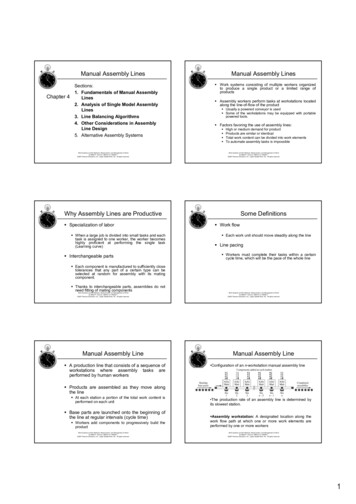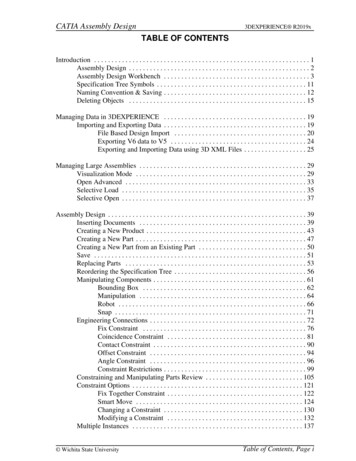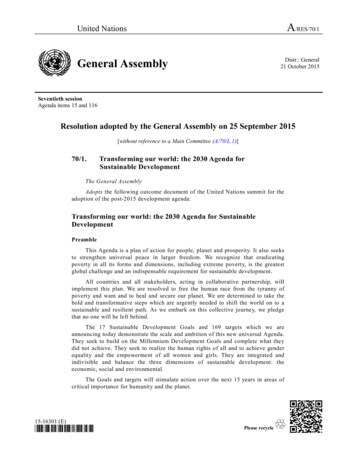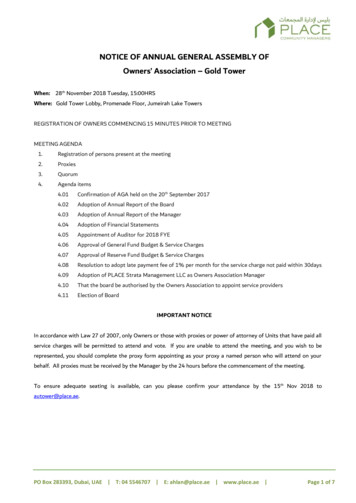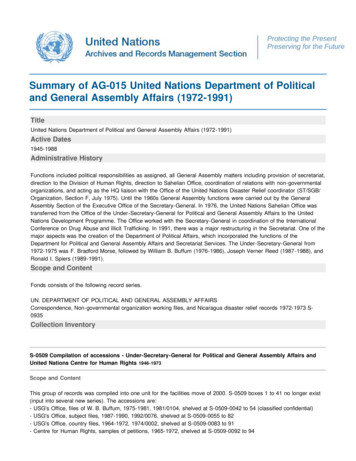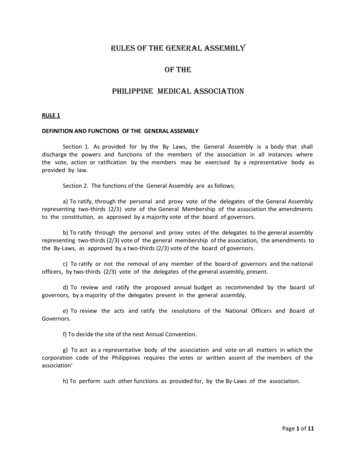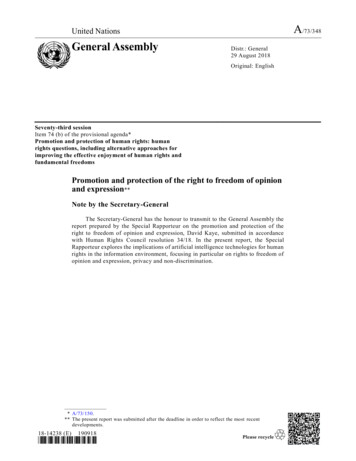
Transcription
A/73/348United NationsGeneral AssemblyDistr.: General29 August 2018Original: EnglishSeventy-third sessionItem 74 (b) of the provisional agenda*Promotion and protection of human rights: humanrights questions, including alternative approaches forimproving the effective enjoyment of human rights andfundamental freedomsPromotion and protection of the right to freedom of opinionand expression**Note by the Secretary-GeneralThe Secretary-General has the honour to transmit to the General Assembly thereport prepared by the Special Rapporteur on the promotion and protection of theright to freedom of opinion and expression, David Kaye, submitted in accordancewith Human Rights Council resolution 34/18. In the present report, the SpecialRapporteur explores the implications of artificial intelligence technologies for humanrights in the information environment, focusing in particular on rights to freedom ofopinion and expression, privacy and non-discrimination.* A/73/150.** The present report was submitted after the deadline in order to reflect the most recentdevelopments.18-14238 (E)190918*1814238*
A/73/348Report of the Special Rapporteur on the promotion andprotection of the right to freedom of opinion and expressionContentsPageI.Introduction . . . . . . . . . . . . . . . . . . . . . . . . . . . . . . . . . . . . . . . . . . . . . . . . . . . . . . . . . . . . . . . . . . .3II.Understanding artificial intelligence . . . . . . . . . . . . . . . . . . . . . . . . . . . . . . . . . . . . . . . . . . . . . . .3A.What is artificial intelligence? . . . . . . . . . . . . . . . . . . . . . . . . . . . . . . . . . . . . . . . . . . . . . . . .3B.Artificial intelligence and the information environment . . . . . . . . . . . . . . . . . . . . . . . . . . .6A human rights legal framework for artificial intelligence . . . . . . . . . . . . . . . . . . . . . . . . . . . . .10A.Scope of human rights obligations in the context of artificial intelligence . . . . . . . . . . . .10B.Right to freedom of opinion . . . . . . . . . . . . . . . . . . . . . . . . . . . . . . . . . . . . . . . . . . . . . . . . . .11C.Right to freedom of expression . . . . . . . . . . . . . . . . . . . . . . . . . . . . . . . . . . . . . . . . . . . . . . .12D.Right to privacy . . . . . . . . . . . . . . . . . . . . . . . . . . . . . . . . . . . . . . . . . . . . . . . . . . . . . . . . . . . .13E.Obligation of non-discrimination . . . . . . . . . . . . . . . . . . . . . . . . . . . . . . . . . . . . . . . . . . . . . .14F.Right to an effective remedy . . . . . . . . . . . . . . . . . . . . . . . . . . . . . . . . . . . . . . . . . . . . . . . . .15G.Legislative, regulatory and policy responses to artificial intelligence . . . . . . . . . . . . . . . .16A human rights-based approach to artificial intelligence . . . . . . . . . . . . . . . . . . . . . . . . . . . . . . .17A.Substantive standards for artificial intelligence systems . . . . . . . . . . . . . . . . . . . . . . . . . . .18B.Processes for artificial intelligence systems . . . . . . . . . . . . . . . . . . . . . . . . . . . . . . . . . . . . .19Conclusions and recommendations . . . . . . . . . . . . . . . . . . . . . . . . . . . . . . . . . . . . . . . . . . . . . . . .21III.IV.V.2/2318-14238
A/73/348I. Introduction1.Artificial intelligence is increasingly influencing the information environmentworldwide. It enables companies to curate search results and newsfeeds as well asadvertising placement, organizing what users see and when they see it. Artificialintelligence technologies are used by social media companies to help moderatecontent on their platforms, often acting as the first line of defence against content thatmay violate their rules. Artificial intelligence recommends people to friend or follow,news articles to read and places to visit or eat, shop or sleep. It offers speed, efficiencyand scale, operating to help the largest companies in the information andcommunications technology sector manage the huge amounts of content uploaded totheir platforms every day. Artificial intelligence technologies may enable b roader andquicker sharing of information and ideas globally, a tremendous opportunity forfreedom of expression and access to information. At the same time, the opacity ofartificial intelligence also risks interfering with individual self-determination, or whatis referred to in the present report as “individual autonomy and agency”. 1 A greatglobal challenge confronts all those who promote human rights and the rule of law:how can States, companies and civil society ensure that artificial intelligencetechnologies reinforce and respect, rather than undermine and imperil, human rights?2.The present report does not pretend to be the last word in artificial intelligenceand human rights. Rather, it tries to do three things: define key terms essential to ahuman rights discussion about artificial intelligence; identify the human rights legalframework relevant to artificial intelligence; and present some preliminaryrecommendations to ensure that, as the technologies comprising artificial intelligenceevolve, human rights considerations are baked into that process. The report should beread as a companion to my most recent report to the Human Rights Council(A/HRC/38/35), in which a human rights approach to online content moderation waspresented. 2II. Understanding artificial intelligenceA.What is artificial intelligence?3.Artificial intelligence is often used as shorthand for the increasingindependence, speed and scale connected to automated, comp utational decisionmaking. Artificial intelligence is not one thing only, but rather refers to a“constellation” of processes and technologies enabling computers to complement orreplace specific tasks otherwise performed by humans, such as making decision s andsolving problems. 3 “Artificial intelligence” can be a problematic term, suggesting asit does that machines can operate according to the same concepts and rules of humanintelligence. They cannot. Artificial intelligence generally optimizes the work of12318-14238See Mariarosaria Taddeo and Luciano Floridi, “How AI can be a force for good”, Science,vol. 361, No. 6404 (24 August 2018). Available at .full.The present report benefited from an expert consultation conducted in Geneva in June 2018,supported with a grant from the European Union, and the input from experts as part of thedevelopment of document A/HRC/35/38 in 2017 and 2018. I especially wish to thank Carly Nystand Amos Toh, who contributed essential research and drafting to this project.See AI Now, “The AI now report: the social and economic implications of artificial intelligencetechnologies in the near term”, 2016. Available at https://ainowinstitute.org/AI Now 2016Report.pdf; United Kingdom of Great Britain and Northern Ireland House of Lords SelectCommittee on Artificial Intelligence, “AI in the United Kingdom: ready, willing and able? ”,2018.3/23
A/73/348computerized tasks assigned by humans through iterative repetition and attempt. Thatsaid, it is the language of the culture, of companies and of governments, and I use ithere.4.Popular culture often suggests that society is headed towards artificial generalintelligence, a still-distant capability (the “singularity”) for a computer system toapproximate or surpass human intelligence across multiple domains. 4 For theforeseeable future, there will continue to be advancements with respect to narrowartificial intelligence, according to which computer systems perform programmedtasks (human-developed algorithms) in specific domains. Narrow artificialintelligence underpins, for example, voice assistance on mobile devices and customerservice chatbots, online translation tools and self-driving cars, search engine resultsand mapping services. Machine-learning is a category of narrow artificial intelligencetechniques used to train algorithms to use datasets to recognize and help solveproblems. For example, artificial intelligence-powered smart home devices arecontinuously “learning” from data collected about everyday language and speechpatterns in order to process and respond to questions from their users more accurately.In all circumstances, humans play a critical role in designing and disseminatingartificial intelligence systems, defining the objectives of an artificial intelligenceapplication and, depending on the type of application, selecting and labelling datasetsand classifying outputs. Humans always determine the application and use of artificialintelligence outputs, including the extent to which they complement or replace humandecision-making.5.At the foundation of artificial intelligence are algorithms, computer codedesigned and written by humans, carrying instructions to translate data intoconclusions, information or outputs. Algorithms have long been essential to theoperation of everyday systems of communication and infrastructure. The enormousvolume of data in modern life and the capacity to analyse it fuel artificial intelligence.The private sector certainly sees data that way: the more data available to feedalgorithms and the better the quality of that data, the more powerful and precise thealgorithms can become. Algorithmic systems can analyse huge volumes of datarapidly, enabling artificial intelligence programmes to perform decision -makingfunctions that were previously the domain of humans acting without computationaltools.44/23Article 19 and Privacy International, “Privacy and freedom of expression in an age of artificialintelligence”, London, 2018.18-14238
A/73/348Human agency is integral to artificial intelligence, but the distinctive characteristicsof artificial intelligence deserve human rights scrutiny with respect to at least threeof its aspects: automation, data analysis and adaptability. 56.Automation. Automation removes human intervention from parts of a decisionmaking process, completing specific tasks with computational tools. This can havepositive implications from a human rights perspective if a design limits human bias.For example, an automated border entry system may flag individuals for scrutinybased on objective features such as criminal history or visa status, limiting relianceon subjective (and bias-prone) assessments of physical presentation, ethnicity, age orreligion. Automation also enables the processing of vast amounts of data at a speedand scale not achievable by humans, potentially serving public safety, health andnational security. However, automated systems rely on datasets that, in their designor implementation, may allow for bias and thus produce discriminatory effects. Forinstance, the underlying criminal history or visa data suggested above itself mayincorporate biases. Excessive reliance on and confidence in automated decisions anda failure to recognize this foundational point may in turn undermine scrutiny ofartificial intelligence outcomes and disable individuals from accessing remedies toadverse artificial intelligence-driven decisions. Automation may impede the518-14238Council of Europe, Algorithms and Human Rights: Study on the Human Rights Dimensions ofAutomated Data Processing Techniques and Possible Regulatory Implications , Council ofEurope study, No. DGI (2017) 12, 2018. Available at ished.5/23
A/73/348transparency and scrutability of a process, preventing even well-meaning authoritiesfrom providing an explanation of outcomes. 67.Data analysis. Vast datasets support most artificial intelligence applications.Any dataset could form the basis of an artificial intelligen ce system, from Internetbrowsing habits to data on traffic flows on highways. Some datasets contain personaldata, while many others involve anonymized data. The use by artificial intelligenceof such datasets raises serious concerns, including regarding their origins, accuracyand individuals’ rights over them; the ability of artificial intelligence systems tode-anonymize anonymized data; and biases that may be ingrained within the datasetsor instilled through human training or labelling of the data. Ar tificial intelligenceevaluation of data may identify correlations but not necessarily causation, which maylead to biased and faulty outcomes that are difficult to scrutinize.8.Adaptability. Machine-learning artificial intelligence systems are adaptable, asthe algorithms that power them are able to progressively identify new problems anddevelop new answers. Depending on the level of supervision, systems may identifypatterns and develop conclusions unforeseen by the humans who programmed ortasked them. This lack of predictability holds the true promise of artificial intelligenceas a transformational technology, but it also illuminates its risks: as humans areprogressively excluded from defining the objectives and outputs of an artificialintelligence system, ensuring transparency, accountability and access to effectiveremedy becomes more challenging, as does foreseeing and mitigating adverse humanrights impacts.B.Artificial intelligence and the information environment9.Artificial intelligence has particularly important, and sometimes problematic,consequences for the information environment, the complex ecosystem oftechnologies, platforms and private and public actors that facilitate access to anddissemination of information through digital means. Algorithms and artificialintelligence applications are found in every corner of the Internet, on digital devicesand in technical systems, and in search engines, social media platforms, messagingapplications and public information mechanisms. In keeping with the focus of mymandate, I note the following three applications of artificial intelligence in theinformation environment that raise concerns:10. Content display and personalization. Social media and search platformsincreasingly dominate how individuals access and share information and ideas andhow news is disseminated. Algorithms and artificial intelligence applicationsdetermine how widely, when and with which audiences and individuals content isshared. Massive datasets that combine browsing histories, user demographics,semantic and sentiment analyses and numerous other factors feed into increasinglypersonalized algorithmic models to rank and curate information, that is, to showinformation to individuals or implicitly exclude it. Paid, sponsored or hashtaggedcontent may be promoted to the exclusion or demotion of other content. Social medianewsfeeds display content according to subjective assessments of how interesting orengaging content might be to a user; as a result, individua ls may be offered little orno exposure to certain types of critical social or political stories and content posted66/23Council of Europe, Algorithms and Human Rights.18-14238
A/73/348to their platforms. 7 Artificial intelligence shapes the world of information in a waythat is opaque to the user and often even to the platform doing the curation.11. Online search is one of the most pervasive forms of artificial intelligence powered content display and personalization. Search engines deliver results forqueries (and complete or predict queries) using artificial intelligence systems thatprocess extensive data about individual and aggregate users. Because poorly rankedcontent or content entirely excluded from search results is unlikely to be seen, theartificial intelligence applications for search have enormous influence ove r thedissemination of knowledge. 8 Content aggregators and news sites 9 similarly choosewhich information to display to an individual based not on recent or importantdevelopments, but on artificial intelligence applications that predict users ’ interestsand news patterns based on extensive datasets. Consequently, artificial intelligenceplays a large but usually hidden role in shaping what information individuals consumeor even know to consume.12. Artificial intelligence in the field of content display is driving towards greaterpersonalization of each individual’s online experience; in an era of informationabundance, 10 personalization promises to order the chaos of the Internet, allowingindividuals to find requested information. Benefits may include th e ability to accessinformation and services in a greater range of languages 11 or information that is moretimely and relevant to one’s personal experience or preferences. Artificialintelligence-driven personalization may also minimize exposure to diverse views,interfering with individual agency to seek and share ideas and opinions acrossideological, political or societal divisions. Such personalization may reinforce biasesand incentivize the promotion and recommendation of inflammatory content ordisinformation in order to sustain users’ online engagement. 12 To be sure, all sorts ofsocial and cultural settings may limit an individual’s exposure to information. But byoptimizing for engagement and virality at scale, artificial intelligence -assistedpersonalization may undermine an individual’s choice to find certain kinds of content.This is especially so because algorithms typically will deprioritize content with lowerlevels of engagement, banishing independent and user-generated content into78910111218-14238World Wide Web Foundation, “The invisible curation of content: Facebook’s News Feed and ourinformation diets”, 22 April 2018. Available at rmation-diets/.Council of Europe, Algorithms and Human Rights.For example, see “How Reuters’s revolutionary AI system gathers global news,” MITTechnology Review, 27 November 2017. Available at erss-revolutionary-ai-system-gathers-global-news/; Paul Armstrong and YueWang, “China’s 11 billion news aggregator Jinri Toutiao is no fake,” Forbes, 26 May 2017.Available at no-fake/#1d8b97804d8a.Carly Nyst and Nick Monaco, State-Sponsored Trolling: How Governments are DeployingDisinformation as Part of Broader Digital Harassment Campaigns (Palo Alto, Institute for theFuture, 2018).World Wide Web Foundation, “Artificial intelligence: the road ahead in low- and middle-incomecountries”, Washington, D.C., 2017.Zeynep Tufekci, “YouTube, the great radicaliser”, New York Times, 10 March 2018. Available y/youtube-politics-radical.html; JamesWilliams, Stand Out of our Light: Freedom and Resistance in the Attention Economy(Cambridge, Cambridge University Press, 2018).7/23
A/73/348obscurity. 13 Savvy actors can exploit rule-based artificial intelligence systemsoptimized for engagement to gain higher levels of exposure, and by appropriatingpopular hashtags or using bots, they can achieve outsized online reach to the detrimentof information diversity.13. Content moderation and removal. Artificial intelligence helps social mediacompanies to moderate content in accordance with platform standards and rules,including spam detection, hash-matching technology (using digital fingerprints toidentify, for instance, terrorist or child exploitation content), keyword filters, naturallanguage processing (by which the nature of the content is assessed for prohibitedwords or imagery) and other detection algorithms. Artificial intelligence may be usedto subject user accounts to warnings, suspension or deactivation on the basis ofviolations of terms of service or may be employed to block or filter websites on thebasis of prohibited domain data or content. Social media companies use artificialintelligence to filter content across the range of their rules (from nudity to harassmentto hate speech and so on), although the extent to which such companies rely onautomation without human input on specific cases is not known. 1414. Support and pressure for increasing the role of artificial intelligence come fromboth the private and public sectors. Companies claim that the volume of illegal,inappropriate and harmful content online far exceeds the capabilities of humanmoderation and argue that artificial intelligence is one tool that can assist in bettertackling this challenge. According to some platforms, artificial intelligence is not onlymore efficient in identifying inappropriate (according to their rules) and illegalcontent for removal (usually by a human moderator) but also has a higher accuracyrate than human decision-making. States, meanwhile, are pressing for efficient,speedy automated moderation across a range of separate challenges, from child sexualabuse and terrorist content, where artificial intelligence is already extensivelydeployed, to copyright and the removal of ‘“extremist” and “hateful” content. 15 TheEuropean Commission Recommendation on measures to further improve theeffectiveness of the fight against illegal content online of March 2018 calls uponInternet platforms to use automatic filters to detect and remove terrorist content, with1314158/23Recently, some tech platforms have indicated their intention to move away from “engagement” —driven personalization to personalization which prioritizes the quality of a user ’s experienceonline; see Julia Carrie Wong, “Facebook overhauls News Feed in favour of ‘meaningful socialinteractions’”, The Guardian, 11 January 2018. Available at berg. However,without thorough transparency, reporting and metrics around how AI systems make and implementsuch assessments, it is difficult to assess whether this change is having a demonstrable effe ct oninternet users’ experience.An Instagram tool, Deep Text, attempts to judge the “toxicity” of the context, as well aspermitting users to customize their own word and emoji filers, and also assesses user relationshipin a further attempt to establish context (such as whether a comment is just a joke betweenfriends). Andrew Hutchison, “Instagram’s rolling out new tools to remove ‘toxic comments’”,Social Media Today, 30 June 2017. Available at ts.The United Kingdom reportedly developed a tool to automatically detect and remove terroristcontent at the point of upload. See, for example, Home Office, “New technology revealed to helpfight terrorist content online”, press release, 13 February 2018. See European Commission,proposal for a directive of the European Parliament and of the Council on Copyright in theDigital Single Market, COM(2016) 593 final, art. 13; Letter from the Special Rapporteur to thePresident of the European Commission, reference No. OL OTH 41/2018, 13 June 2018. Availableat islation/OL-OTH-41-2018.pdf.18-14238
A/73/348human review in some cases suggested as a necessary counterweight to the inevitableerrors caused by the automated systems. 1615. Efforts to automate content moderation may come at a cost to human rights (seeA/HRC/38/35, para. 56). Artificial intelligence-driven content moderation has severallimitations, including the challenge of assessing context and taking into accountwidespread variation of language cues, meaning and linguistic and culturalparticularities. Because artificial intelligence applications are often grounded indatasets that incorporate discriminatory assumptions, 17 and under circumstances inwhich the cost of over-moderation is low, there is a high risk that such systems willdefault to the removal of online content or suspension of accounts that are notproblematic and that content will be removed in accordance with biased ordiscriminatory concepts. As a result, vulnerable groups are the most likely to bedisadvantaged by artificial intelligence content moderation systems. For example,Instagram’s DeepText identified “Mexican” as a slur because its datasets werepopulated with data in which “Mexican” was associated with “illegal”, a negativelycoded term baked into the algorithm. 1816. Artificial intelligence makes it difficult to scrutinize the logic behind contentactions. Even when algorithmic content moderation is complemented by hu manreview — an arrangement that large social media platforms argue is increasinglyinfeasible on the scale at which they operate — a tendency to defer to machine-madedecisions (on the assumptions of objectivity noted above) impedes interrogation ofcontent moderation outcomes, especially when the system’s technical design occludesthat kind of transparency.17. Profiling, advertising and targeting. Advances in artificial intelligence haveboth benefited from and further incentivized the data -driven business model of theInternet, namely, that individuals pay for free content and services with their personaldata. With the vast data resources amassed from years of online monitoring andprofiling, companies are able to equip artificial intelligence systems with rich datasetsto develop ever more precise prediction and targeting models. Today, advertising byprivate and public actors can be achieved at an individual level; consumers and votersare the subject of “microtargeting” designed to respond to and exploit individualidiosyncrasies.18. Artificial intelligence-driven targeting incentivizes the widespread collectionand exploitation of personal data and increases the risk of manipulation of individualusers through the spread of disinformation. Targeting can perpetuate discrimination,as well as users’ exclusion from information or opportunities by, for example,permitting targeted job and housing advertisements that exclude older workers,16171818-14238Commission recommendation of 1 March 2018 on measures to effectively tackle illegal contentonline (C(2018) 1177 final). Available at ckle-illegal-content-online; see also DaphneKeller, “Comment in response to European Commission’s March 2018 recommendation onmeasures to further improve the effectiveness of the fight against illegal content online”, StanfordLaw School, Center for Internet and Society, 29 March 2018. Available dation-measures-further.See Aylin Caliskan, Joanna Bryson and Arvind Narayanan, “Semantics derived automaticallyfrom language corpora contain human-like biases”, Science, vol. 356, No. 6334 (14 April 2017);Solon Barocas and Andrew Selbst, “Big data’s disparate impact”, California Law Review,vol. 104, No. 671 (2016).Nicholas Thompson, “Instagram’s Kevin Systrom wants to clean up the &#%@! Internet”,Wired, 14 August 2017. Available at romwants-to-clean-up-the-internet/.9/23
A/73/348women or ethnic minorities. 19 Rather than individuals being exposed to parity anddiversity in political messaging, for example, the deployment of microtargetingthrough social media platforms is creating a curated worldview inhospitable topluralistic political discourse.III. A human rights legal framework for artificial intelligenceA.Scope of human rights obligations in the context ofartificial intelligence19. Artificial intelligence tools, like all technologies, must be designed, developedand deployed so as to be consistent with the obligations o f States and theresponsibilities of private actors under international human rights law. Human rightslaw imposes on States both negative obligations to refrain from implementingmeasures that interfere with the exercise of freedom of opinion and expressi on andpositive obligations to promote rights to freedom of opinion and expression and toprotect their exercise.20. With respect to the private sector, States are bound to guarantee respect forindividual rights, 20 especially the rights to freedom of opinion and expression,including by protecting individuals from infringing acts committed by private parties(article 2 (1) of the International Covenant on Civil and Political Rights). States canmeet this obligation through legal measures to restrict or in fluence the developmentand implementation of artificial intelligence applications, through policies regardingthe procurement of artificial intelligence applications from private companies bypublic sector actors, through self- and co-regulatory schemes and by building thecapacity of private sector companies to recognize and prioritize the rights to freedomof opinion and expression in their corporate endeavours.21. Companies also have responsibilities under human rights law that should guidetheir construction, adoption and mobilization of artificial intelligence technologies(A/HRC/38/35, para. 10). The Guiding Principles on Business and Human Rights:Implementing the United Nations “Protect, Respect and Remedy” Framework providea “global standard of expected conduct for all businesses wherever they operate ”(principle 11), including social media and search companies. To adapt the conclusionsfrom the Guiding Principles to the domain of artificial intelligence (ibid., para. 11),the Guiding Principles require that companies, at a minimum, make high -level policycommitments to respect the human rights of their users in all artificial intelligenceapplications (principle 16); avoid causing or contributing to adverse human rightsimpacts through their use of artificial intelligence technology and prevent andmitigate any adverse effects linked to their operations (principle 13); conduct duediligence on artificial intelligence systems to identify and address actual and potentialhuman rights impacts (principles 17–19); engage in prevention and mitigationstrategies (principle 24); conduct ongoing review of artificial intelligence-r
intelligence underpins, for example, voice assistance on mobile devices and customer service chatbots, online translation tools and self-driving cars, search engine results and mapping services. Machine-learning is a category of narrow artificial intelligence techniques used to train algorithms to use datasets to recognize and help solve problems.

